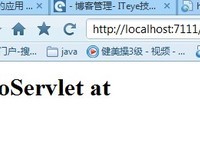1. Web services概念
Web services是客户端和
服务端通过万维网的
HTTP协议进行交互.
3.JAX-WS实现简单的Web services
3.1 建一个名为HelloServer的Web应用作为
Webservice客户端
3.2 在HelloServer应用下新建一个类:
package helloservice.endpoint;
import javax.jws.WebMethod;
import javax.jws.WebService;
@WebService
public class Hello {
private String message = new String("Hello, ");
public void Hello() {
}
@WebMethod
public String sayHello(String name) {
return message + name + ".";
}
}
3.3 在weblogic下发布HelloServer应用,应用名为WebRoot
3.4 在IE里面打开http://localhost:7001/WebRoot/HelloService?wsdl
如果可以查看到wsdl的内容说明发布成功.比如:
<?xml version="1.0" encoding="UTF-8" ?>
- <!-- Published by JAX-WS RI at http://jax-ws.dev.java.net. RI's version is Oracle JAX-WS 2.1.3-07/10/2008 08:41 PM(bt).
-->
- <!-- Generated by JAX-WS RI at http://jax-ws.dev.java.net. RI's version is Oracle JAX-WS 2.1.3-07/10/2008 08:41 PM(bt).
-->
- <definitions xmlns:soap="http://schemas.xmlsoap.org/wsdl/soap/" xmlns:tns="http://endpoint.helloservice/" xmlns:xsd="http://www.w3.org/2001/XMLSchema" xmlns="http://schemas.xmlsoap.org/wsdl/" targetNamespace="http://endpoint.helloservice/" name="HelloService">
- <types>
- <xsd:schema>
<xsd:import namespace="http://endpoint.helloservice/" schemaLocation="http://localhost:7001/WebRoot/HelloService?xsd=1" />
</xsd:schema>
</types>
- <message name="sayHello">
<part name="parameters" element="tns:sayHello" />
</message>
- <message name="sayHelloResponse">
<part name="parameters" element="tns:sayHelloResponse" />
</message>
- <portType name="Hello">
- <operation name="sayHello">
<input message="tns:sayHello" />
<output message="tns:sayHelloResponse" />
</operation>
</portType>
- <binding name="HelloPortBinding" type="tns:Hello">
<soap:binding transport="http://schemas.xmlsoap.org/soap/http" style="document" />
- <operation name="sayHello">
<soap:operation soapAction="" />
- <input>
<soap:body use="literal" />
</input>
- <output>
<soap:body use="literal" />
</output>
</operation>
</binding>
- <service name="HelloService">
- <port name="HelloPort" binding="tns:HelloPortBinding">
<soap:address location="http://localhost:7001/WebRoot/HelloService" />
</port>
</service>
</definitions>
3.5 运行wsimport
wsimport是JDK1.6特有的,[JAVA_HOME]/bin下.
3.5.1 在E:\Program Files\PowerCmd>目录下,新建一个文件夹generate.
3.5.2 运行如下命令:
wsimport -s generate http://localhost:7001/WebRoot/HelloService?wsdl
如果返回
parsing WSDL...
generating code...
说明运行成功.
3.5.3 查看generate目录,可以看到生成了JAVA文件,与generate同级的目录下,还有class文件.(这里生成的JAVA文件,客户端需要用到)
生成的HelloService.java如下:
package helloservice.endpoint;
import java.net.MalformedURLException;
import java.net.URL;
import javax.xml.namespace.QName;
import javax.xml.ws.Service;
import javax.xml.ws.WebEndpoint;
import javax.xml.ws.WebServiceClient;
import javax.xml.ws.WebServiceFeature;
/**
* This class was generated by the JAX-WS RI.
* JAX-WS RI 2.1.1 in JDK 6
* Generated source version: 2.1
*
*/
@WebServiceClient(name = "HelloService", targetNamespace = "http://endpoint.helloservice/", wsdlLocation = "http://localhost:7001/WebRoot/HelloService?wsdl")
public class HelloService
extends Service
{
private final static URL HELLOSERVICE_WSDL_LOCATION;
static {
URL url = null;
try {
url = new URL("http://localhost:7001/WebRoot/HelloService?wsdl");
} catch (MalformedURLException e) {
e.printStackTrace();
}
HELLOSERVICE_WSDL_LOCATION = url;
}
public HelloService(URL wsdlLocation, QName serviceName) {
super(wsdlLocation, serviceName);
}
public HelloService() {
super(HELLOSERVICE_WSDL_LOCATION, new QName("http://endpoint.helloservice/", "HelloService"));
}
/**
*
* @return
* returns Hello
*/
@WebEndpoint(name = "HelloPort")
public Hello getHelloPort() {
return (Hello)super.getPort(new QName("http://endpoint.helloservice/", "HelloPort"), Hello.class);
}
/**
*
* @param features
* A list of {@link javax.xml.ws.WebServiceFeature} to configure on the proxy. Supported features not in the <code>features</code> parameter will have their default values.
* @return
* returns Hello
*/
@WebEndpoint(name = "HelloPort")
public Hello getHelloPort(WebServiceFeature... features) {
return (Hello)super.getPort(new QName("http://endpoint.helloservice/", "HelloPort"), Hello.class, features);
}
}
3.6 建一个名为HelloClient的Web应用作为WebService客户端
3.7 将3.5.3生成的JAVA文件复制到HelloClient的src下.
3.8 新建一个Hello
Servlet文件,如下:
package webclient;
import helloservice.endpoint.HelloService;
import java.io.IOException;
import java.io.PrintWriter;
import javax.servlet.ServletException;
import javax.servlet.annotation.WebServlet;
import javax.servlet.http.HttpServlet;
import javax.servlet.http.HttpServletRequest;
import javax.servlet.http.HttpServletResponse;
import javax.xml.ws.WebServiceRef;
@WebServlet(name = "HelloServlet", urlPatterns = { "/HelloServlet" })
public class HelloServlet extends HttpServlet {
@WebServiceRef(wsdlLocation = "http://localhost:7001/WebRoot/HelloService?wsdl")
private HelloService service;
/**
* Constructor of the object.
*/
public HelloServlet() {
super();
}
/**
* Destruction of the servlet. <br>
*/
public void destroy() {
super.destroy(); // Just puts "destroy" string in log
// Put your code here
}
/**
* The doGet method of the servlet. <br>
*
* This method is called when a form has its tag value method equals to get.
*
* @param request the request send by the client to the server
* @param response the response send by the server to the client
* @throws ServletException if an error occurred
* @throws IOException if an error occurred
*/
public void doGet(HttpServletRequest request, HttpServletResponse response)
throws ServletException, IOException {
processRequest(request, response);
}
/**
* The doPost method of the servlet. <br>
*
* This method is called when a form has its tag value method equals to post.
*
* @param request the request send by the client to the server
* @param response the response send by the server to the client
* @throws ServletException if an error occurred
* @throws IOException if an error occurred
*/
public void doPost(HttpServletRequest request, HttpServletResponse response)
throws ServletException, IOException {
processRequest(request, response);
}
/**
* Initialization of the servlet. <br>
*
* @throws ServletException if an error occurs
*/
public void init() throws ServletException {
// Put your code here
}
/**
* Processes requests for both HTTP <code>GET</code> and <code>POST</code>
* methods.
*
* @param request
* servlet request
* @param response
* servlet response
* @throws ServletException
* if a servlet-specific error occurs
* @throws IOException
* if an I/O error occurs
*/
protected void processRequest(HttpServletRequest request,
HttpServletResponse response) throws ServletException, IOException {
response.setContentType("text/html;charset=UTF-8");
PrintWriter out = response.getWriter();
try {
out.println("<html lang=\"en\">");
out.println("<head>");
out.println("<title>Servlet HelloServlet</title>");
out.println("</head>");
out.println("<body>");
out.println("<h1>Servlet HelloServlet at "
+ request.getContextPath() + "</h1>");
out.println("<p>" + sayHello("world") + "</p>");
out.println("</body>");
out.println("</html>");
} finally {
out.close();
}
}
// doGet and doPost methods, which call processRequest, and
// getServletInfo method
private String sayHello(java.lang.String arg0) {
helloservice.endpoint.Hello port = service.getHelloPort();
return port.sayHello(arg0);
}
}
3.9 配置HelloClient的Web.xml,增加如下代码:
<servlet>
<description>HelloServlet</description>
<display-name>HelloServlet</display-name>
<servlet-name>HelloServlet</servlet-name>
<servlet-class>webclient.HelloServlet</servlet-class>
</servlet>
<servlet-mapping>
<servlet-name>HelloServlet</servlet-name>
<url-pattern>/servlet/HelloServlet</url-pattern>
</servlet-mapping>
3.10 发布HelloClient应用
3.11 在IE录入http://localhost:7111/servlet/HelloServlet
页面内容如下说明WebService调用成功!


- 大小: 32.9 KB
